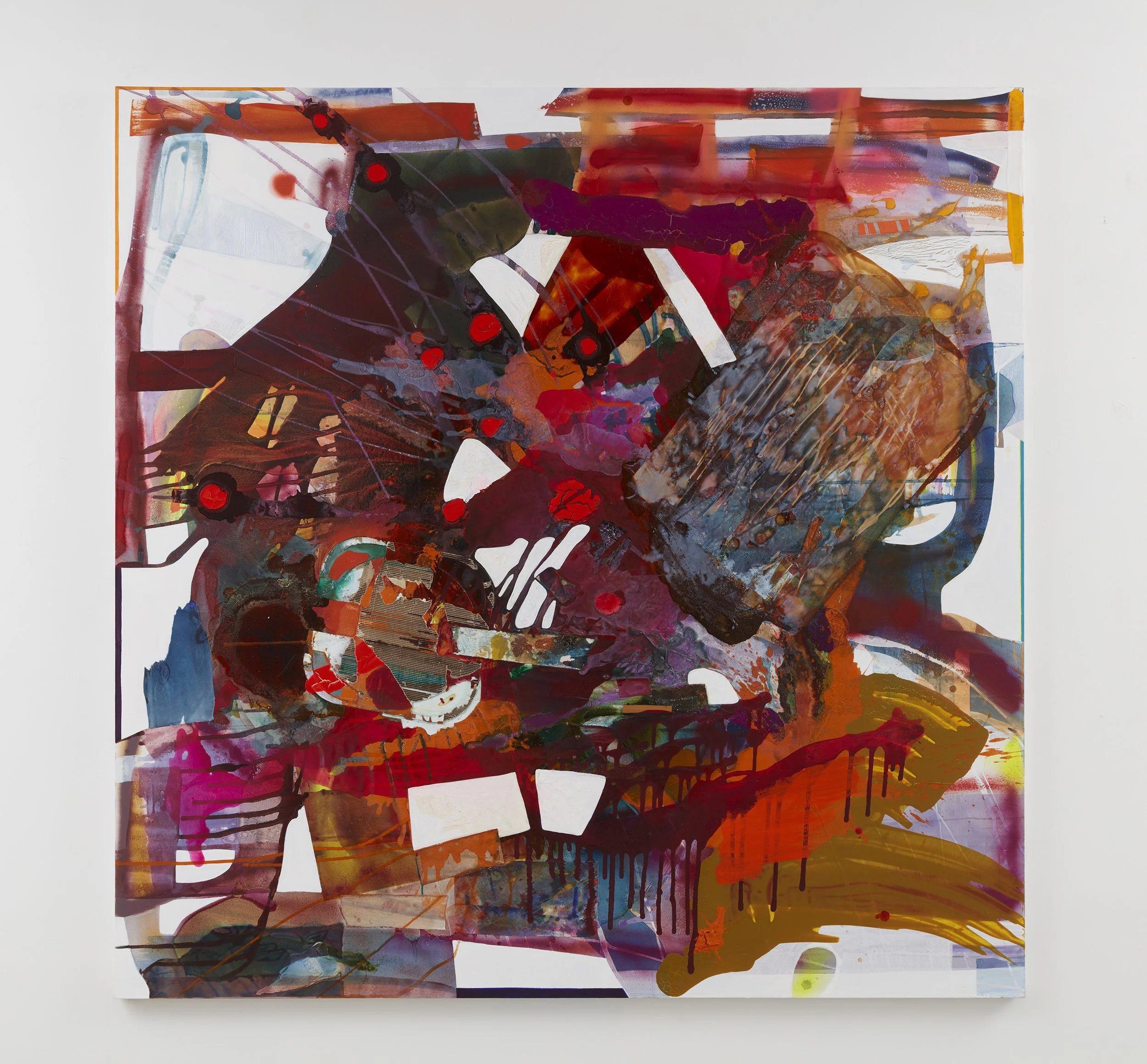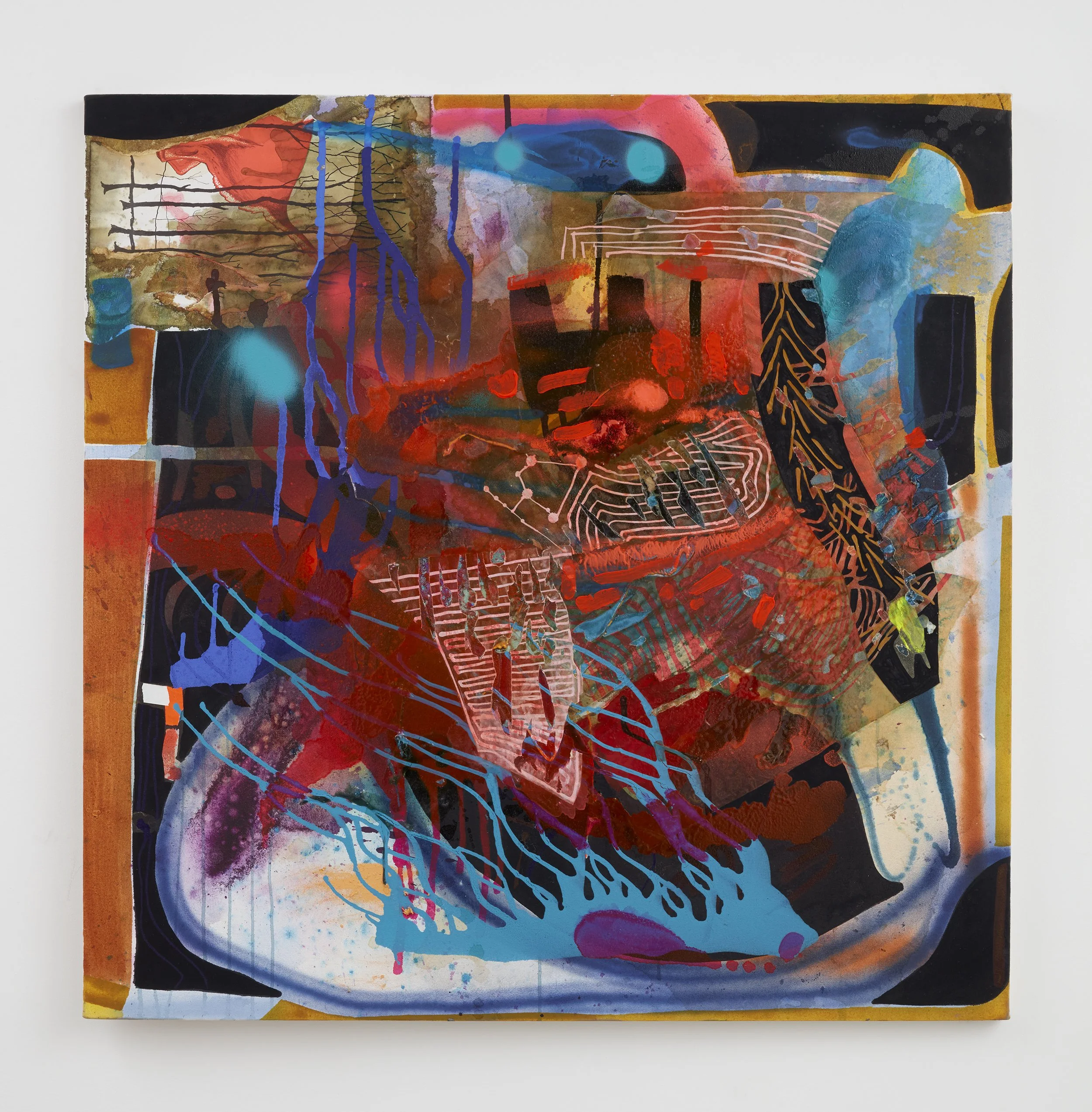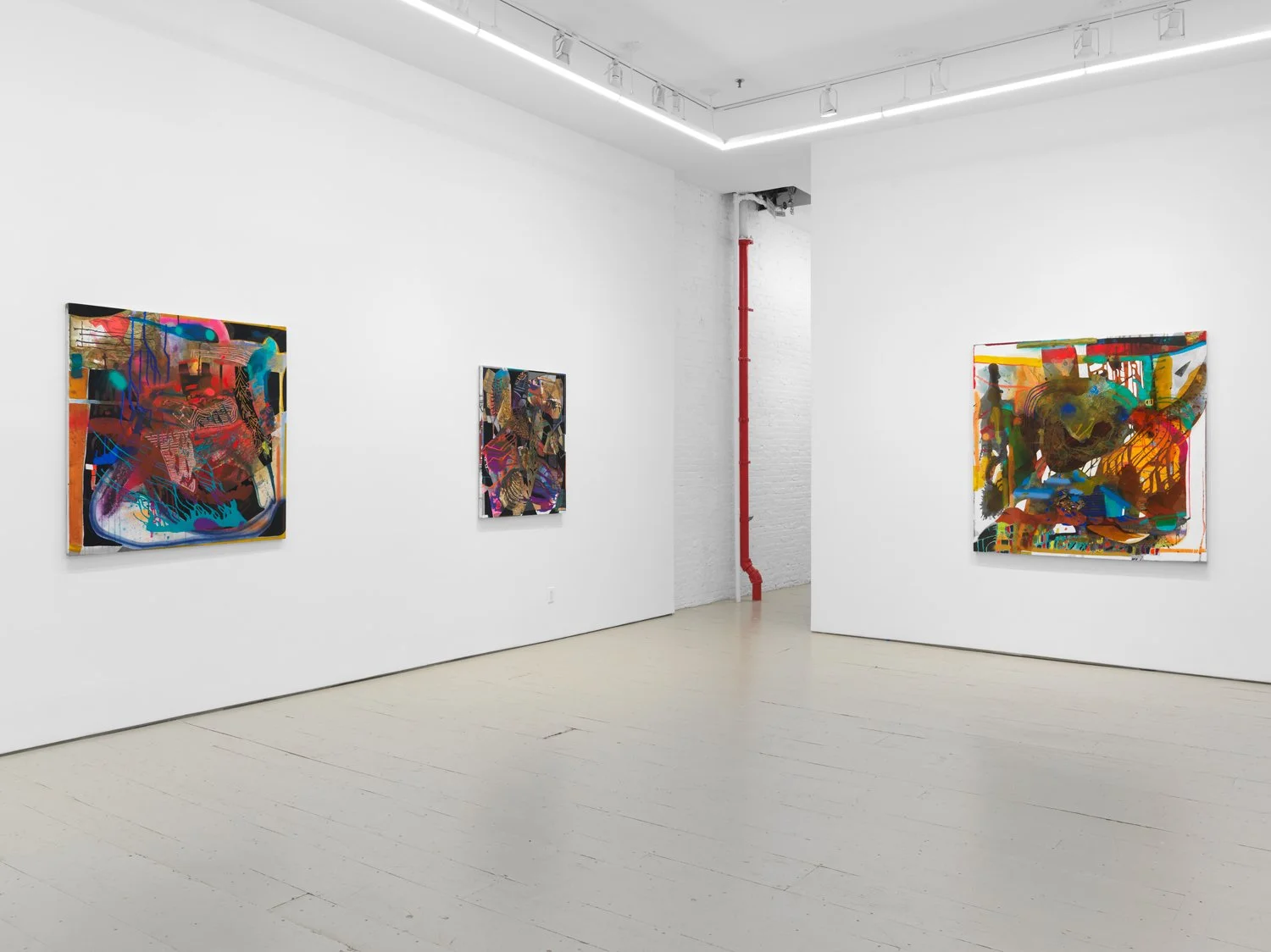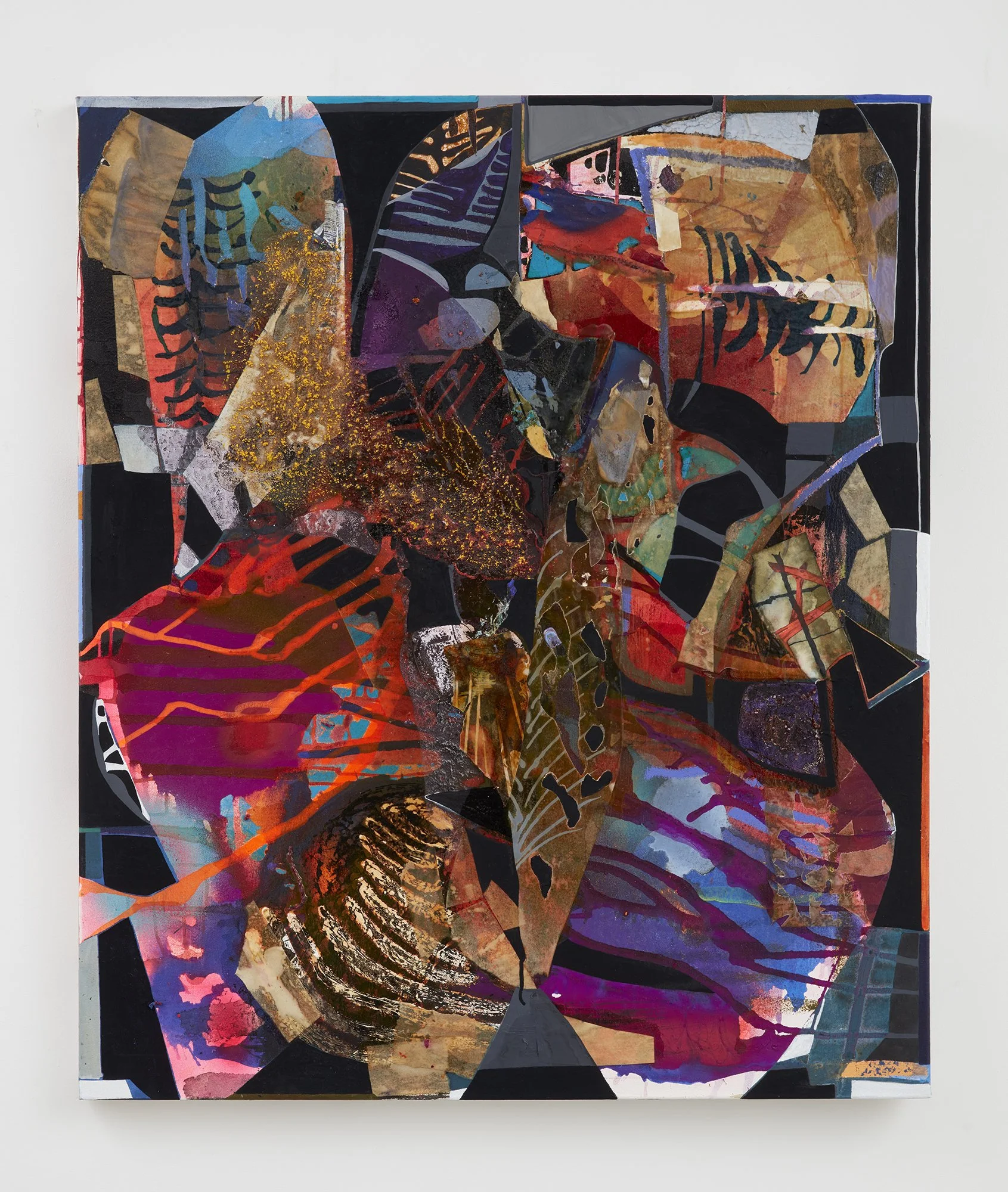The Somatic Paintings of Erika Ranee
Erika Ranee, “My Saturn Return” at Klaus Von Nichtssagend, installation view
Skin is the largest organ of the body, home to over four million pores, each one a threshold. The epidermis is not only a boundary but a porous membrane between self and environment, a breathing eye through which consciousness meets the world. The canvas, like the body, is an envelope of sensation, holding a field of awareness that does not end at its edges. Erika Ranee’s generous and life-affirming paintings embody this expansive understanding. As figurative representations, they depict the liminal space beneath the surface of skin. In her abstract works, color and material, channeled by an intuitive process, point to a primordial knowing. As both literal and metaphorical portals, her exuberant paintings suggest the farther in you go, the further out you get.
Erika Ranee, Fever Dream, 2025, acrylic, shellac, spray paint, oil stick, and paper collage, 30 x 26 inches
Ranee’s work emerges from a rich lineage of artists who have used abstraction as a liberating strategy. For minority and historically marginalized artists, abstraction has often served as a necessary refusal, a resistance to the flattening gaze of representation, which too often reduces “the other” to objects of trauma or exoticism. The evolution of Ranee’s work – from early representational engagements with racist propaganda and oppressive stereotypes to her current process-based abstractions – reflects a shift from the outwardly facing image to inwardly felt truth. This inversion of the gaze, from surface to source, dissolves spectacle and performance, inviting intimacy with space itself. Abstraction picks up where narrative fails, conveying the uncontainable complexity and multiplicity of being.
Erika Ranee, I'm Fine, 2025, acrylic, shellac, spray paint, and Flashe, 72 x 72 inches
Cinema is an unexpected influence in Ranee’s practice. An aficionado of Japanese New Wave film, Ranee cites Kaneto Shindo’s Onibaba (1965) and Hiroshi Teshigahara’s The Woman in the Dunes (1964) as two of her favorite features. In both, identity is stripped bare, transformed and ultimately surrendered through a confrontation with elemental forces. Sand, sweat, mask, and flesh serve as agents of karmic revelation, pressing characters into contact with the primal layers of self underlying social form. The protagonists of each film undergo a slow undoing that leaves the ego flayed and porous. This molting process echoes the Ranee’s themes of transformation and unworlding. Her abstractions do not escape identity but compost it, such that personal and cultural psychic debris become fertile ground for new self-knowledge. Ego is not destroyed; it is diffused and recirculated into a larger field of awareness.
Jack Whitten, one of Ranee’s mentors, likewise saw abstraction not as an escape from identity but as a quantum field through which Blackness could thrive. In Wet: On Painting, Feminism, and Art Culture, Mira Schor further explores this function, exhorting minority artists to critically engage with and transform the traditions that once excluded them. Working within the language of abstraction – historically, a white, male-dominated arena – Ranee invoked Schor’s vision of painting as critique and self-inscription in her solo show My Saturn Return at Klaus von Nichtssagend Gallery, infusing her work with lived experience while documenting the failure of the medical system. Like Whitten’s work, Ranee’s is layered through pouring, scraping, obscuring, and embedding to form a repository where presence and infinite time are woven together into a kind of visual DNA.
Erika Ranee, Thumbs Up, 2025, acrylic, shellac, spray paint, oil stick and paper collage, 72 x 72 inches
Alongside Ranee, we might consider Sun Ra, whose Afrofuturist cosmology offered not a rejection of the present, but an escape velocity from its constraints. Ranee’s paintings vibrate with celestial purples, veined neons, and luminous blacks. Her use of color, especially purple, carries a distinct frequency, one associated with the crown chakra, royalty, spirituality and mourning. Simultaneously purple is non-spectral, existing between categories, the impossible space between red and blue. Absent from the visible light spectrum, purple is a construct, conjured by the eye and brain. In this context, Ranee’s liberal use of purple becomes not just a hue but a vehicle. Ranee’s purples undulate, bleed and echo across her canvases, suggesting both the corporeal and cosmic, wound and aura, shadow and atmosphere. The color purple operates as a strategy of unfolding, allowing Ranee to explore identity not as something fixed, historical, or measurable but as something somatically registered and beyond perception.
Erika Ranee, A Big Bowl, 2025, acrylic, shellac, spray paint, gouache and paper collage, 48 x 48 inches
Ranee’s surfaces are energetic matrices, activated through gesture, medium and attention. Shellac, ink, spray paint, and acrylic fuse with found materials and botanical forms. Shellac, in particular, is a living material — a biological secretion collected from tree bark where lac insects formed colonies. Once scraped, it is processed into flakes and sold in orange, amber or clear forms, often with its arthropod manufactures entombed. It seals porous materials, binds mixed media layers and creates shine and depth. In Ranee’s work shellac is an etheric secretion, evoking superlunary ectoplasm that links the somatic with intergalactic, vegetal and entomological states. The material specificity of this gooey membrane is an umbilicus to awareness itself, signaling growth cycles of gestation and labor. As a hardener and beautifier, it embodies preservation and transformation.
Erika Ranee, “My Saturn Return” at Klaus Von Nichtssagend, installation view
Ranee’s motifs often resemble cross-sections of the body or the land featuring veins, roots, braids, cracked sidewalks and floral membranes as recurring ladders. There is a sense of descent in the work, a sinking into intuition, of allowing knowledge to arise from inside. This is where Ranee’s practice intersects with what might be called a soul-based epistemology, a way of knowing that bypasses the linearity of narrative and taps instead into somatic intelligence. Her improvised gestures are acts of listening, guided by the nervous system. In that locus, abstraction becomes a spiritual technology. It is how the body speaks before it has been named, how the soul arrives before the story is told.
Erika Ranee, Anesthesia, 2025, acrylic, shellac, spray paint, gouache, oil stick, and collage on canvas, 42 x 36 inches
Ranee’s paintings are a reclamation of the self as more-than-self. They propose that the body is a conductor of ongoing revelation, inseparable from earth and sky. Each painting becomes a somatic cosmogram, a way of remembering what the thinking mind cannot hold. They are a reminder that healing is not ascent but descent and involves intimacy with root systems. Beneath the surface of language, biography and expectation, Ranee’s paintings are visceral archives, where memory becomes matter unlocking the layered strata of being. Appearing as if they are backlit, these luminous beacons tap into an understanding of what we actually are, revealing the body’s capacity to remember what the mind forgets.
Erika Ranee: My Saturn Return at Klaus von Nichtssagend Gallery, 87 Franklin Street, Ground Floor, New York, NY. May 29–July 11, 2025.






